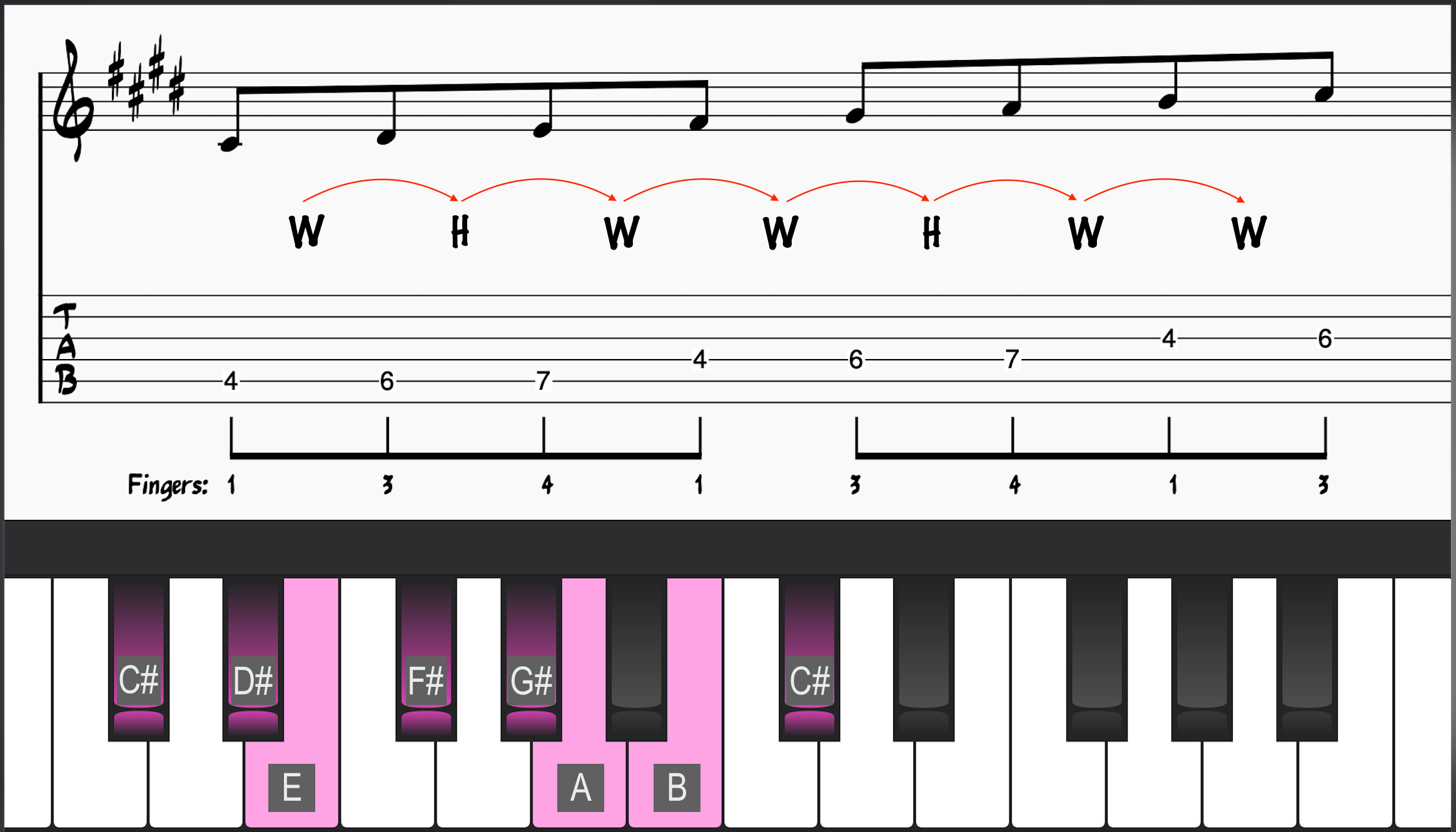Did you know that the Aeolian scale and the natural minor scale are actually the same scale? Music theory can sometimes be a little confusing, but we’ll clear the air and help you learn the Aeolian scale (and natural minor scale) in all 12 keys!
We’ll also explore why the Aeolian scale is also called the natural minor scale and how it can be both the parent scale of minor keys and one of the major scale modes.
And, if you are looking to seriously improve your musicianship skills and play better solos (and understand what you’re doing!), take a second and check out the Learn Jazz Standards Inner Circle.
We’ve got a bunch of incredible jazz and music education resources to help you reach your musicianship goals. From instrument-specific courses to masterclasses on improvisation and jazz theory, we have the goods you need to take it to the next level.
Improve in 30 days or less. Join the Inner Circle.
Table of Contents
The Aeolian Scale Formula and Scale Degrees

Let’s jump right in and learn the characteristics of the Aeolian scale!
The natural minor scale formula is:
- W-H-W-W-H-W-W
From A, this minor scale would be spelled:
- A-B-C-D-E-F-G-A
Its scale degree breakdown is:
- Root Note (A)
- Major 2nd (B)
- Minor 3rd (C)
- Perfect 4th (D)
- Perfect 5th (E)
- Minor 6th (F)
- Minor 7th (G)
- Root Note (A)
If you are confused by musical intervals like perfect fifth or minor sixth, check out our guide to music intervals.
Now that we have basic introductions out of the way, let’s explore how and why the Aeolian mode and the major scale share the same notes. Essentially, we’ll answer the question as to why this scale is both a parent scale (for minor keys) and also the sixth mode of the major scale (major keys).
Is it the Natural Minor Scale or the Aeolian Mode?
Well, it’s both, actually.
Relative major and minor keys have a unique relationship. Every major and minor key is built from the same scale sequence. We usually call this sequence the major scale, but it is equally the minor scale too, because the sequences are the same.
What changes is where you start in the sequence. Besides that, they are basically the same scale and share the same notes:

If every major key has a relative minor key, it follows that every major scale has a relative minor scale.
When playing in major keys, the Aeolian mode is built from the sixth scale degree of the major scale. When playing in minor keys, the Ionian mode (major scale) is built from the third scale degree of the minor scale.
- C Major and A Minor
- F Major and D Minor
- Bb Major and G Minor
- Eb Major and C minor
- Ab Major and F Minor
- Db Major and Bb Minor
- F# Major and D# Minor
- B Major and G# Minor
- E Major and C# Minor
- A Major and F# Minor
- D Major and B Minor
- G Major and E Minor
Let’s briefly explore the concept of modes to help solidify this concept.
What are the Diatonic Modes?
The major scale is a sequence of notes that repeat. A C major scale is spelled:
- C-D-E-F-G-A-B-C
- W-W-H-W-W-W-H
However, you don’t need to start on C to play this sequence of notes. When you play this sequence of notes from a note other than C, you end up with a different seven-note scale. This is because we are changing what we consider the starting point in a fixed and asymmetrical sequence of steps.
If you start the sequence on D instead, your scale formula changes:
- D-E-F-G-A-B-C-D
- W-H-W-W-W-H-W
This creates a Dorian minor scale, which is a unique mode of the C major scale. If you do this from each note in the C major scale sequence, you get all the diatonic modes:
- Ionian Mode (Major scale or First Mode)
- C-D-E-F-G-A-B-C
- W-W-H-W-W-W-H
- Dorian Mode (Second Mode)
- D-E-F-G-A-B-C-D
- W-H-W-W-W-H-W
- Learn more about Dorian minor here
- Phrygian Mode (Third Mode)
- E-F-G-A-B-C-D-E
- H-W-W-W-H-W-W
- Lydian Mode (Fourth Mode)
- F-G-A-B-C-D-E-F
- W-W-W-H-W-W-H
- Learn more about Lydian here
- Mixolydian Mode (Fifth Mode)
- G-A-B-C-D-E-F-G
- W-W-H-W-W-H-W
- learn more about the Mixolydian mode here
- Aeolian Mode (Sixth Mode)
- A-B-C-D-E-F-G-A
- W-H-W-W-H-W-W
- Locrian Mode (Seventh Mode)
- B-C-D-E-F-G-A-B
- H-W-W-H-W-W-W
For more on the modes of the major scale, check out our guide to the seven modes.
Diatonic Chords in Minor Keys
When we harmonize the notes in the Aeolian mode, we get the minor key chords. They are the same chords as in the relative major key; however, what we count as the I chord changes.

Let’s compare chords in the key of C major with chords in the key of A minor:
Major Key Chords:
- I. chord (Cmaj7; Ionian mode)
- ii. chord (D-7; Dorian Mode)
- iii. chord (E-7; Phrygian Mode)
- IV. (Fmaj7; Lydian Mode)
- V. (G7; Mixolydian Mode)
- vi. chord (A-7; Aeolian Mode)
- viiø. chord (B-7b5; Locrian Mode)
Minor Key Chords:
- i. chord (A-7; Aeolian Mode)
- iiø. chord (B-7b5; Locrian Mode)
- III chord (Cmaj7; Ionian mode)
- iv. chord (D-7; Dorian Mode)
- v. chord (E-7; Phrygian Mode)
- VI. chord (Fmaj7; Lydian Mode)
- VII. chord (G7; Mixolydian Mode)
Now we’re ready to actually learn how to play this scale on guitar and piano!
Aeolian Scales in 12 Keys on Guitar and Piano
The Aeolian scale consists of a root note, a major second (M2), a minor third (m3), a perfect fourth and perfect fifth (P4 and P5), a minor sixth (m6), and a minor seventh (m7) scale degree. Here is this minor mode in all twelve keys:
A Aeolian Scale
- A-B-C-D-E-F-G
- W-H-W-W-H-W-W

D Aeolian Scale
- D-E-F-G-A-Bb-C-D
- W-H-W-W-H-W-W

G Aeolian Scale
- G-A-Bb-C-D-Eb-F-G
- W-H-W-W-H-W-W

C Aeolian Scale
- C-D-Eb-F-G-Ab-Bb-C
- W-H-W-W-H-W-W

F Aeolian Scale
- F-G-Ab-Bb-C-Db-Eb-F
- W-H-W-W-H-W-W

Bb Aeolian Scale
- Bb-C-Db-Eb-F-Gb-Ab-Bb
- W-H-W-W-H-W-W

BEFORE YOU CONTINUE...
If music theory has always seemed confusing to you and you wish someone would make it feel simple, our free guide will help you unlock jazz theory secrets.

Eb Aeolian Scale
- Eb-F-Gb-Ab-Bb-C-Db-Eb
- W-H-W-W-H-W-W

G# Aeolian Scale
- G#-A#-B-C#-D#-E-F#-G#
- W-H-W-W-H-W-W

C# Aeolian Scale
- C#-D#-E-F#-G#-A#-B-C#
- W-H-W-W-H-W-W

F# Aeolian Scale
- F#-G#-A-B-C#-D-E-F#
- W-H-W-W-H-W-W

B Aeolian Scale
- B-C#-D-E-F#-G-A-B
- W-H-W-W-H-W-W

E Aeolian Scale
- E-F#-G-A-B-C-D-E
- W-H-W-W-H-W-W

Aeolian Mode Compared to Other Minor Scales
Let’s compare Aeolian minor to other minor scales, like the other minor modes and the harmonic minor melodic minor scales.
The other minor modes are Dorian, Phrygian, and Locrian.
The Aeolian mode has the following scale degrees:
A-B-C-D-E-F-G-A (C Major)
- Rt.
- M2
- m3
- P5
- P5
- m6
- m7
The Dorian mode has a major sixth scale degree instead of a minor sixth scale degree:
A-B-C-D-E-F#-G-A (G major)
- Rt.
- M2
- m3
- P4
- P5
- M6
- m7
The Phrygian Mode has minor sixth and seventh scale degrees and a minor second scale degree:
A-Bb-C-D-E-F-G-A (F Major)
- Rt.
- m2
- m3
- P4
- P5
- m6
- m7
The Harmonic Minor scale is a non-diatonic scale, which means it does not derive from the major scale, like the Aeolian mode, Dorian mode, Phrygian mode, or Locrian mode. This non-diatonic scale has a minor sixth and a major seventh, creating a minor third distance between the 6th and 7th scale degrees.

A-B-C-D-E-F–G#-A
- Rt.
- M2
- m3
- P4
- P5
- m6
- M7
For more information regarding harmonic minor, check out our article on the harmonic minor scale.
The Melodic Minor scale is another non-diatonic scale (at least when ascending in classical music). It has a major sixth and a major seventh.

A-B-C-D-E-F#–G#-A
- Rt.
- M2
- m3
- P4
- P5
- M6
- M7
For more on melodic minor and its modes, check out our guide to the melodic minor scale.
Learn How To Improvise Using All The Minor and Major Scales! Join The Inner Circle!
Want to take what you’ve learned here and use it to play better solos?
The Learn Jazz Standards Inner Circle offers abundant resources on jazz improvisation, including workshops, masterclasses, and deep dives into jazz standards. There’s no better place to be if you want to seriously improve on your instrument and take your jazz playing to the next level.









